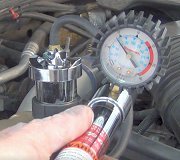If you're going to do this kind of higher-level testing the best investment you can make is to buy the manufacturer's service manual. It is extremely uncommon for wires to go bad as in broken or shorted together so the last thing to consider is following wires into a harness. That's like trying all the different roads to get to a far-away city without looking at a road map.
ABS wheel speed connectors are normally hidden where water and road salt won't spray onto them. If in doubt, look them up on rockauto. Com. They have dandy pictures. Your wheel speed sensor connectors are right next to the wheel bearings, right out in the open.
GM has been having a real lot of trouble with wheel speed sensors and your car uses this design with the sensor pressed on the back of the bearing assembly. The bearings develop some play which is completely normal, but that play lets the speed signals drop out to where they're too low in voltage to be detected by the computer. That can happen in as little as 15,000 miles. The dealer's scrap metal bins are loaded full of old bearings.
To start with, there will be a diagnostic fault code stored in the ABS Computer. Reading that code is the place to start. Many codes do not erase automatically so you have to do that once repairs are completed. To add to the frustration of mechanics and owners, there is always a long list of conditions that must be met to set a code and one of those conditions is that certain other codes can't be in memory already. For example, the computer knows that when the brakes are not applied, all four sensors should be reporting the same speed. If it gets no signal from one sensor, it can't use that signal to compare to other sensors so it won't run some of the self tests. That's usually not a problem if you have a defect fixed right away but if you wait, a second problem might develop but not be detected. In the case of these sensors, there can be one fault code and that's what the mechanic goes by to give you an estimate on repair cost. Once that bearing assembly is replaced and the code erased, the computer will have a good signal to compare to the other sensors, and on the test drive the new code will come up for the other front sensor. The customer thinks the mechanic didn't diagnose the problem correctly and the mechanic is frustrated because he had no way of knowing there was another problem.
Once you have the service manual, if you still want to do wiring tests, you can read the resistance between two wires right at the computer's connector. That reading will include any potential corroded connector terminals, or breaks in the circuit. If you get the specified resistance, there's no need to tear into a harness. Physically the circuit is good; now you have to see if a signal is being produced magnetically in the sensor. You can measure the AC voltage on those wires too when running the engine in gear with the front end raised up on jack stands.
SPONSORED LINKS
Monday, October 22nd, 2012 AT 5:22 AM



